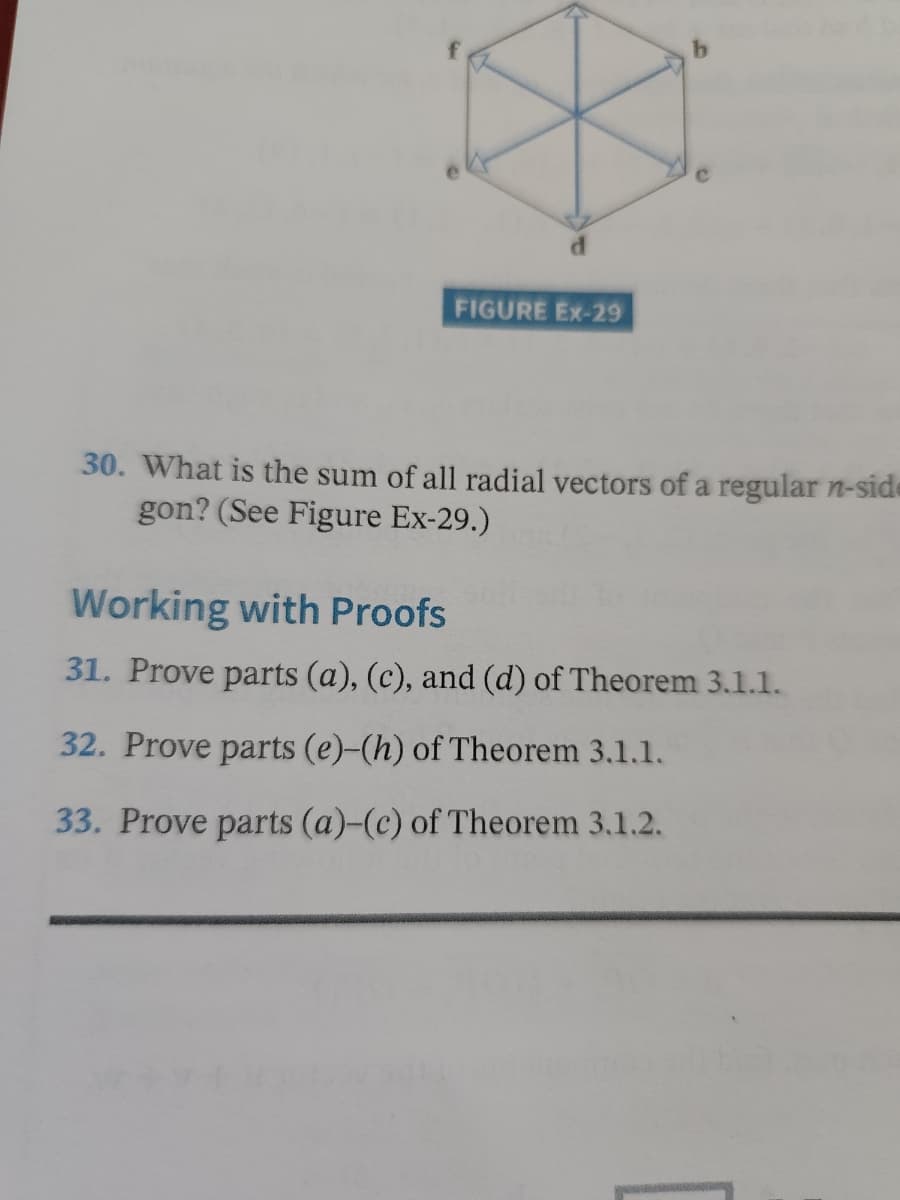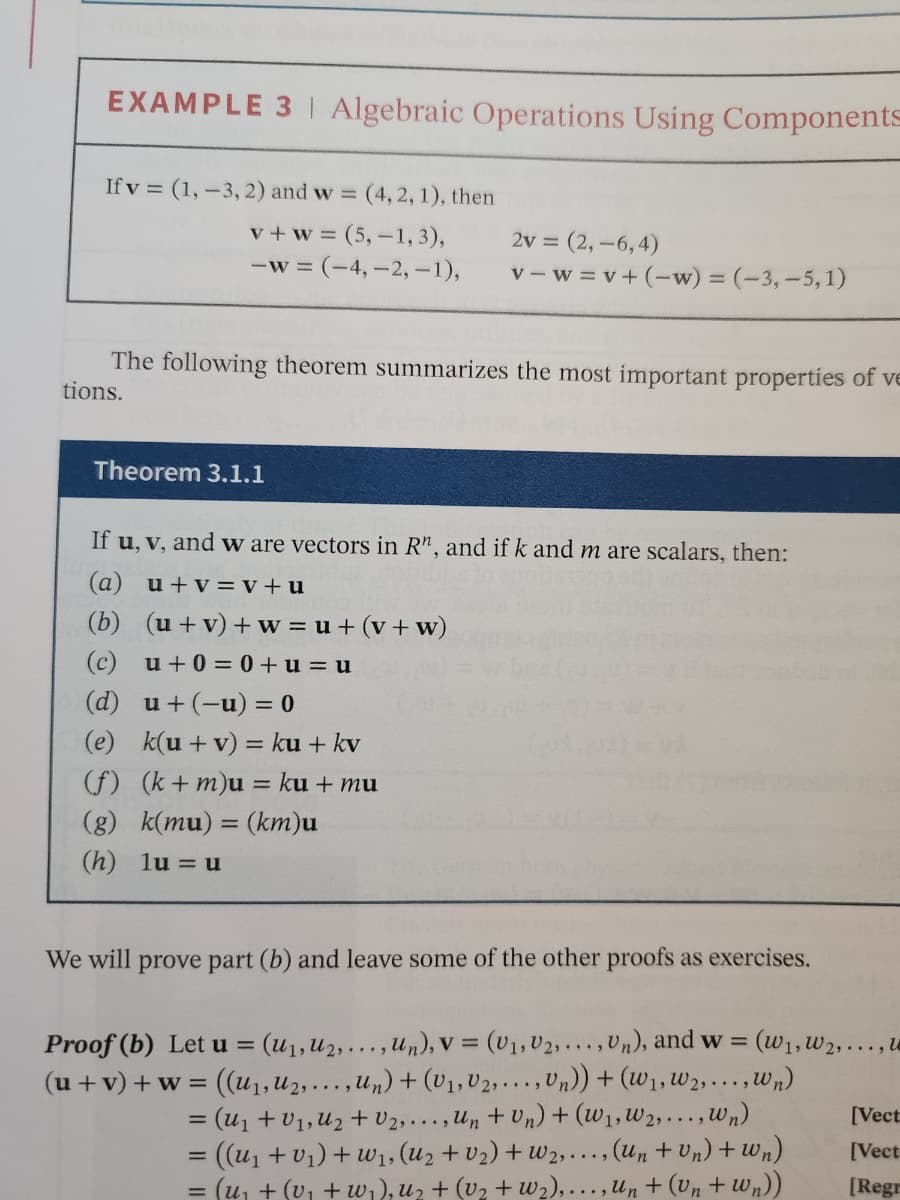Linear Algebra: A Modern Introduction
4th Edition
ISBN:9781285463247
Author:David Poole
Publisher:David Poole
Chapter1: Vectors
Section1.3: Lines And Planes
Problem 34EQ
Related questions
Question
100%
31 on paper please

Transcribed Image Text:FIGURE Ex-29
30. What is the sum of all radial vectors of a regular n-side
gon? (See Figure Ex-29.)
Working with Proofs
31. Prove parts (a), (c), and (d) of Theorem 3.1.1.
32. Prove parts (e)-(h) of Theorem 3.1.1.
33. Prove parts (a)-(c) of Theorem 3.1.2.

Transcribed Image Text:EXAMPLE 3 | Algebraic Operations Using Components
If v = (1, -3, 2) and w = (4, 2, 1), then
v+w=(5,-1, 3),
2v = (2,-6,4)
-w = (-4,-2, -1),
v-w=v+(-w) = (-3, -5,1)
The following theorem summarizes the most important properties of ve
tions.
Theorem 3.1.1
If u, v, and w are vectors in R", and if k and m are scalars, then:
(a) u + v=v+u
(b) (u+v)+w=u+ (v + w)
(c) u+0=0+u=u
(d) u + (-u) = 0
(e) k(u + v) = ku + kv
(f) (k+m)u = ku + mu
(g) k(mu) = (km)u
(h) lu= u
We will prove part (b) and leave some of the other proofs as exercises.
Proof (b) Let u = (U₁, U₂, ..., Un), V = (U₁, U₂, ..., Un), and w = (W1, W2,...,U
(u + v) + w = ((U₁, U₂,..., Un) + (V₁, V₂,..., Un)) + (W₁, W₂,..., wn)
[Vect
=
= (U₁ + V₁, U₂+U2,..., Un + Un) + (W₁, W2,..., wn)
= ((U₁ + v₁) + w₁, (u₂ + V₂) + W2,...,
.., (un + vn) + wn)
[Vect
[Regr
= (u₁ + (v₁ + w₁), U₂ + (V₂ + W₂),..., Un + (Un+wn))
Expert Solution
This question has been solved!
Explore an expertly crafted, step-by-step solution for a thorough understanding of key concepts.
This is a popular solution!
Trending now
This is a popular solution!
Step by step
Solved in 3 steps with 3 images

Recommended textbooks for you

Linear Algebra: A Modern Introduction
Algebra
ISBN:
9781285463247
Author:
David Poole
Publisher:
Cengage Learning

Algebra & Trigonometry with Analytic Geometry
Algebra
ISBN:
9781133382119
Author:
Swokowski
Publisher:
Cengage

Trigonometry (MindTap Course List)
Trigonometry
ISBN:
9781305652224
Author:
Charles P. McKeague, Mark D. Turner
Publisher:
Cengage Learning

Linear Algebra: A Modern Introduction
Algebra
ISBN:
9781285463247
Author:
David Poole
Publisher:
Cengage Learning

Algebra & Trigonometry with Analytic Geometry
Algebra
ISBN:
9781133382119
Author:
Swokowski
Publisher:
Cengage

Trigonometry (MindTap Course List)
Trigonometry
ISBN:
9781305652224
Author:
Charles P. McKeague, Mark D. Turner
Publisher:
Cengage Learning